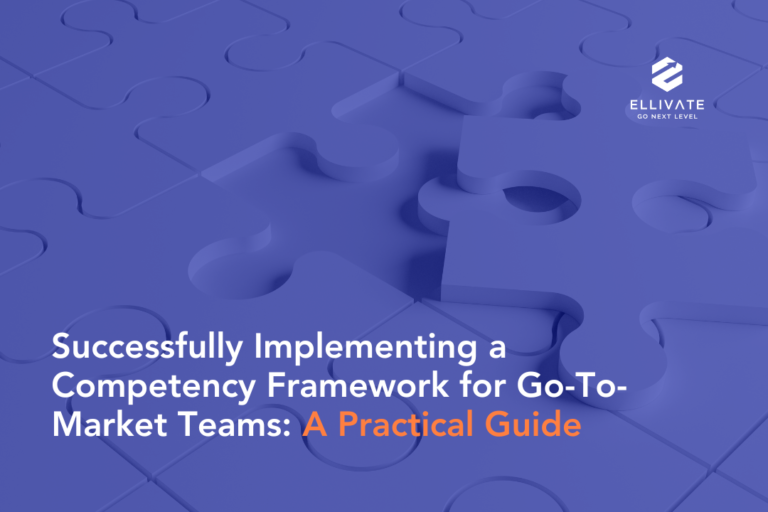Competencies are a set of skills, abilities, and knowledge that are essential for employees to perform their job functions effectively. In building high-performing go-to-market teams, competencies are crucial in attracting and developing talent.
Competencies are critical to the success of any organisation, as they enable employees to perform their duties efficiently and effectively. They are not limited to technical skills but also include behavioural traits and soft skills necessary for effective teamwork, communication, and collaboration. Competencies can be categorised into different types, such as technical, behavioural, and leadership competencies, depending on the specific job roles and responsibilities.
In building high-performing go-to-market teams, competencies are particularly crucial because of the fast-paced and dynamic nature of the marketplace. These teams must be able to adapt quickly to changing market trends and customer needs, and they require a diverse set of skills and abilities to do so effectively.
Competencies also play a vital role in attracting and retaining top talent, as they provide employees with a clear understanding of what is expected of them and the skills they need to succeed in their roles. They enable employees to perform their duties while providing a clear roadmap for talent development and career growth.
Our 7-Step Approach for Building a Competency Framework

Building a role and function-specific competency framework is essential in developing a high-performing go-to-market team. This process involves a series of steps and considerations that are critical to ensure that the framework accurately reflects the skills, knowledge, and behaviours required for success in specific roles and functions.
These are our 7 steps that a business must follow to build a role and function-specific competency framework:
Step 1: Define the Purpose and Scope of the Framework
This involves identifying the specific roles and functions that the framework will cover and the particular skills, knowledge, and behaviours required for success in these roles.
Step 2: Conduct a Job Analysis
Gather information about the specific tasks, responsibilities, requirements, and desired outcomes of each job, as well as the skills and knowledge required to perform these tasks effectively.
Step 3: Identify Competencies
Based on the job analysis, identify the competencies that are required for success in each role or function. Competencies may include technical skills, behavioural traits, and soft skills such as communication, problem-solving, and teamwork.
Step 4: Develop Competency Definitions
These definitions should clearly articulate what each competency entails and its relevance to the specific role or function.
Step 5: Determine Proficiency Levels
This involves defining the different levels of proficiency required for each competency based on the specific role or function. Examples may include Aware, Developing, Proficient and Advanced. Clear definitions need to be stated for each level of proficiency.
Step 6: Develop Assessment Tools
To assess employees’ proficiency in each competency, businesses must develop assessment tools, such as performance metrics, self-assessment questionnaires, and behavioural assessments.
Step 7: Implement the Framework
Once the competency framework has been developed, the next step is implementing it across the organisation. This involves training managers and employees on the framework and integrating it into the recruitment, onboarding, and performance management processes.
There are several reasons why building a role and function-specific competency framework is optimal for creating a high-performing go-to-market team.
- It ensures that employees have the specific skills and knowledge required for success in their roles, which enables them to perform their duties effectively and efficiently.
- It provides a clear roadmap for talent development and career growth, which helps to attract and retain top talent.
- It enables businesses to identify skill gaps and training needs, which can be addressed through targeted learning and development initiatives.
The top 4 challenges in developing a competency framework and how to avoid them.
Developing a competency framework for go-to-market teams can be a complex and challenging process. While the framework is essential for building a high-performing team, organisations may encounter several challenges during development.
1. Identifying the Right Competencies
This involves understanding the specific skills, knowledge, and behaviours required for success in each role and function. Failing to identify the right competencies can lead to skill gaps and ineffective performance. To avoid this, organisations should involve subject matter experts in the development process. These experts can provide insights into the specific skills and knowledge required for each role and function. Additionally, businesses can conduct job analysis and gather input from current employees to ensure that the competencies identified are relevant and accurate.
2. Ensuring the Framework is Comprehensive and Balanced
This means the framework should cover all the critical skills and behaviours required for success in each role and function. Failing to develop a comprehensive and balanced framework can lead to incomplete skill sets and ineffective performance. Organisations should involve multiple stakeholders in the development process. This includes subject matter experts, managers, and employees. These stakeholders can provide input and feedback on the identified competencies, ensuring the framework is comprehensive and balanced.
3. Integrating the Framework into Existing Processes
This includes recruitment, onboarding, and performance management processes. Failing to integrate the framework into existing processes can lead to ineffective implementation and inconsistent performance. To avoid this, organisations should develop a comprehensive implementation plan. This plan should include training for managers and employees on the competency framework and integrating the framework into existing processes, such as job descriptions, recruitment, onboarding, and performance management. Organisations should regularly review and update the framework to ensure it remains relevant and effective.
4. Ensuring Employee Buy-In
Failing to gain employee buy-in can lead to resistance, ineffective implementation, and low morale.
Involve employees in the development process to avoid this by gathering input and feedback on the identified competencies and providing training and development opportunities that align with the framework. Additionally, organisations should communicate the framework’s benefits to employees, such as career development and growth opportunities.
Developing a competency framework for go-to-market teams can be challenging, but implementing a comprehensive and balanced framework that is integrated into existing processes and gains employee buy-in can lead to a high-performing team with the skills and knowledge required for success.

The Core Business Benefits You Can Expect from a Successful Competency Framework Implementation
By successfully integrating the competency framework into organisational processes and culture, organisations can realise the full benefits of the framework and achieve greater success. These include:
- Improved Talent Management:
Implementing a competency framework effectively can help organisations to better manage their talent by providing a standardised approach to defining, measuring, and developing employee skills and abilities. This can help to ensure that employees have the necessary skills and knowledge to perform their jobs effectively and that development opportunities are aligned with organisational goals and priorities. - Enhanced Performance:
By providing clear expectations for job performance and development and by helping to identify areas for improvement. This can improve productivity, higher-quality work, and better customer satisfaction. - Increased Employee Engagement:
By providing employees with a clear understanding of what is expected of them and development opportunities that align with their career goals and aspirations. This can lead to increased motivation, job satisfaction, and employee retention. - Better Business Outcomes:
By aligning employee skills and abilities with organisational goals and priorities. This can lead to increased revenue, improved profitability, and enhanced competitive advantage.
A competency framework is a vital tool for building high-performing go-to-market teams. By integrating the competency framework into the organisation’s processes and culture, businesses can fully realise its benefits and achieve greater success. Ultimately, investing in developing and implementing a competency framework is a worthwhile endeavour that can help organisations attract and retain top talent, stay competitive, and achieve their strategic goals.

Need help implementing a Competency Framework?
If you are an organisation looking to implement a competency framework, Ellivate can help you get started. Our team of experts has extensive experience in developing and implementing competency frameworks for businesses of all sizes and in a variety of industries. We have frameworks that you can use off the shelf or customise to support your organisation’s needs.
Contact us today to learn more about our services and to take your competency frameworks to the Next Level.




